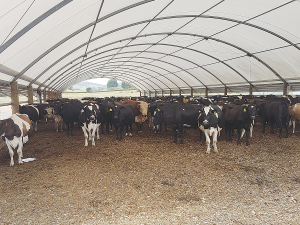Turning data into dollars
If growing more feed at home adds up to $428 profit per tonne of dry matter to your bottom line, wouldn’t it be good to have a ryegrass that gets you there quicker?
 Allowing cows to eat at a set feeding pad helps to ensure that all animals have access to the same amount and quality of feed.
Allowing cows to eat at a set feeding pad helps to ensure that all animals have access to the same amount and quality of feed.
In New Zealand, every dairy farmer worth their salt knows just how important it is to look after the welfare of their animals. The health of the herd directly impacts profit margins, which, in turn, determines the viability and sustainability of the farm.
Farmers who ignore the feed and nutrition management of their herd do so at their peril. Beyond the severe legal penalties awaiting those who choose to neglect the welfare of animals under their care, there is also a substantial opportunity cost to be missed should farmers not get the most milk production out of their herd, as underweight cows almost always result in poorer dairy yields and lower fertility rates.
By closely monitoring the nutrition levels in feed, farmers can start to take the guesswork out of milk solid production and animal health issues – but it doesn’t start and end at the food supply.
A comprehensive approach to nutrition management should consider the many factors that play into the wellbeing of a dairy cow – from pasture management, to supplementation and water supply, to the availability of feed pads and shelter – there is a lot that can be done to increase the productivity and welfare of working cows, safeguarding the sustainability of the farm by providing healthy profit margins in the process.
Here are some tips to help improve the feed and nutrition of your dairy farm.
Pasture management is a key part of a comprehensive approach that ensures dairy cattle are supplied with the right amount of nutrition to meet their needs.
While it is a very broad subject in itself, good pasture management has six key points to follow, as highlighted below:
Rotational Grazing
The implementation of a rotational grazing system allows for optimal utilisation of the pasture, allowing forage to recuperate and grow back in time. This ensures that cows have access to fresh, high-quality forage, while reducing the risk of overgrazing.
Soil Fertility
By maintaining the soil fertility of pastures through regular soil testing and applying the appropriate fertilisers, cows are supplied with nutritious grasses for foraging.
Weed control
Weeds reduce the quality of pasture and compete with desirable forage, such as grasses. Implementing an effective weed control program (such as herbicide application or mechanical weed removal) helps to maintain the quality of the pasture.
Irrigation
A timeless farming technique practised since 6000 BC, irrigation provides a steady flow of adequate water throughout fields, allowing pastures to reach their potential, thereby providing nutritious forage for cows. Irrigation is especially important during dry spells.
Rest Periods
As a subset of rotational grazing, the idea of giving pastures adequate rest periods for pasture regrowth is crucial to maintaining a sustainable grazing system. Rest periods should be long enough to allow for adequate regrowth, but not too long that the pasture becomes too mature, and therefore less nutritious.
Monitoring and Consultation
By regularly monitoring pasture quality, quantity, and cow performance through Body Condition Scores, farmers can make informed decisions about pasture management and feeding strategies, removing the need for guesswork. Consultation with a veterinarian or qualified dairy cattle nutritionist may also be appropriate for farmers to determine the best nutrition program for their herd’s needs.
A feeding pad is a hard-surfaced area designed for feeding and managing dairy cows. Covered feed pad barns, such as those supplied by SmartShelters, help to prevent against the negative effects of heat stress by keeping the sun off of cows while feeding and keeping their body temperatures cool and regulated.
There are several other ways in which a feed pad improves the nutrition management of dairy cows:
Reducing Pasture Damage
Cows that are continuously fed on pasture may overgraze and damage the pasture, which is especially true in fields that are harder to monitor (either for access, distance, or other geographic reasons). Using a feeding pad can help reduce pasture damage and allow for optimal pasture utilisation.
Monitoring
Feeding pads provide a controlled environment for feeding, enabling easy monitoring of feed intake and cow behaviour. This can help farmers’ lives easier in that they can then make informed decisions about nutrition management, feed intake, observe individual cows for ailments, and easily monitor the overall health of the herd.
Article sourced from www.smartshelters.co.nz
Farmers are being urged to keep on top of measures to control Cysticerus ovis - or sheep measles - following a spike in infection rates.
For more than 50 years, Waireka Research Station at New Plymouth has been a hub for globally important trials of fungicides, insecticides and herbicides, carried out on 16ha of orderly flat plots hedged for protection against the strong winds that sweep in from New Zealand’s west coast.
There's a special sort of energy at the East Coast Farming Expo, especially when it comes to youth.
OPINION: The latest reforms of local government should come as no surprise.
The avocado industry is facing an extremely challenging season with all parts of the supply chain, especially growers, being warned to prepare for any eventuality.
Rural recycling scheme Agrecovery is welcoming the Government's approval of regulations for a nationwide rural recycling scheme for agrichemicals and farm plastics.
OPINION: Dipping global dairy prices have already resulted in Irish farmers facing a price cut from processors.
OPINION: Are the heydays of soaring global demand for butter over?